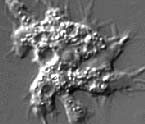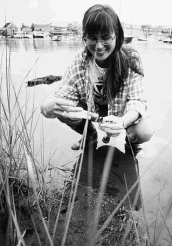
|
Archives:
Summer 2000 Table
of Contents
Present in the air, soil, fresh water, and marine sediments, they are part of a healthy ecosystem. They consume bacteria and other small organisms, and help move organic nutrients through the food web. On the downside, they can act as carriers of pathogenic bacteria such as Legion-ella, and can cause systemic infections in humans by invading tissues of the eye, brain, lung, or skin–sometimes with deadly results. An Acanthamoeba, approximately 15-20 microns in size, are single-celled organisms that can live almost anywhere, often tolerating unfavorable conditions such as drought, extreme temperatures, and lack of food supply, thanks to their ability to form a dormant cyst. As cysts, acanthamoebae are resistant to chlorine treatment, which allows them to persist in drinking water supplies and chlorinated swimming pools, and their presence in stool samples is indicative of their ability to survive the human digestive process.
Since that time, Gast, now an assistant scientist in the biology department at the Woods Hole Oceano-graphic Institution (WHOI), has focused her research on Acantha-moeba to their presence and distribution in marine sediments. While Gast says it is known that acanthamoebae will tolerate salinity, and that acanthamoebae can be cultured from marine sediment samples, it is not clear whether they grow in marine environments. And, says Gast, although they may not represent a serious human health threat in the marine environment, their ability to harbor other nasty organisms might. Presently, Gast is interested in the potential of Acanthamoeba as an indicator of sewage or waste dumps in deepwater marine sites–places where acanthamoebae would not otherwise be present. Though previous studies of acanthamoebae in deepwater marine sediments off New York Bight correlate well with coliform bacteria presence within the dump area, drawing a clear connection between the presence of acanthamoebae and sewage is not straightforward. For one thing, explains Gast, "most of what we know now is based upon enrichment culture, and it is becoming apparent that this method can give a biased picture of the species present." Also, she says, it is not clear how long acanthamoebae persist in an environment, particularly a marine environment. "We assume that the cysts can be around for a long time because that is how we maintain them as stocks in the laboratory," she says, "but that doesn’t necessarily relate directly to the natural environment." To learn more about acanthamoebae in marine environments, Gast received funding from WHOI Sea Grant to sample a number of sites, including Eel Pond, a small saline embayment located just outside her office building in Woods Hole. Though a short walk at low tide constitutes the "field work" portion of her research, the laboratory work involves state-of-the-art molecular biology techniques. Once the cores are in her lab, Gast isolates the DNA, conducts PCR amplification with specific primers for Acan-thamoeba, and uses these products as probes. Such probes, explains Gast, are used to detect and identify the organisms on what is called a reverse dot-blot. This technique offers a pictorial representation from which Gast can determine which ribotype, or group of Acanthamoeba, are present in the samples. One advantage of this technique is that it allows for the detection of more than one ribotype in a single sample, when present.
Gast performs her technique directly on sediment samples and on enrichment cultures–cultures generated from the core sediments. She has been finding differences between the cultured sample and the original sediment core. Gast says this indicates that "ribotypes present in culture–an opportunistic environment–do not reflect those dominant in the environment." According to Gast, this finding serves as confirmation that "our current view of the natural distribution of acanthamoebae is potentially biased." Acanthamoeba isolates, or major types, are grouped by sequences and clusters, with new isolates being mapped all the time. It wasn’t long ago, she says, that scientists knew of 18 sequences and 4 clusters; today there are 53 known sequences and 12 clusters. Most of Gast’s research revolves around one cluster, known as T4. Within the very large T4 ribotype group are both environmental (naturally-occurring) and pathogenic (human disease) isolates–in particular, the isolates associated with corneal infections. Information gained by the reverse dot-blot comparison of direct and culture enrichment analyses of Acanthamoeba ribotypes suggests that the T4 ribotype is not necessarily abundant in the environment, but that members seem to respond well to culture conditions. This ability could be part of what allows some of these isolates to establish infections in humans. Gast’s reverse dot-blot technique, with its ribotype-specific oligonucleotide probes, differs from other identification methods, which do not offer the specificity needed to distinguish between the many different isolates. While their utility as an indicator of sewage may be premature, Gast believes the presence of acanthamoebae in the marine environment could indicate some form of human impact. She hopes to further explore this possibility by sampling marine sediments in pre- and post-outfall Massachusetts Bay locations. |

